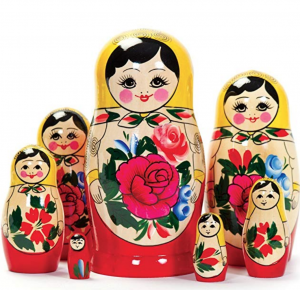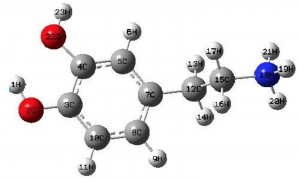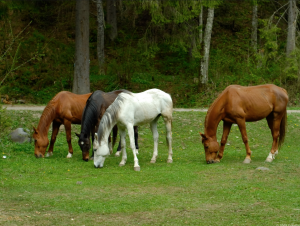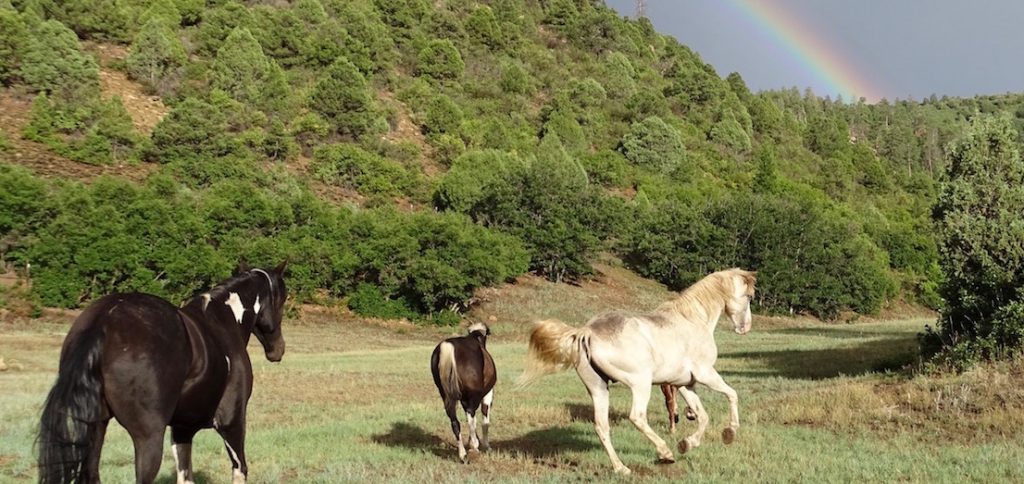 What is a smile or a handshake?
What is a smile or a handshake?
The answer is like a Matryoshka doll with another doll inside it and then another doll inside that one.
Sure, they’re gestures of welcome. But neurologically speaking, they are the manifestations of a bundle of voluntary and involuntary movements. Inside that doll, they are the result of action along neural pathways, involving the firing of millions of synapses. And within that doll, the handshake or smile is ultimately influenced by the scores of neurochemicals, traveling and existing in relative homeostasis in our brains and throughout our bodies.
Neurochemicals like dopamine and serotonin are prominent in most mammals and their functions are multifold. They play a role in almost everything we do.
 For instance, we know dopamine as the chemical of reward, but it’s also vital to movement (Parkinson patients, for instance, lose the ability to produce dopamine. Therefore, they may struggle to perform voluntary movements without taking synthetic dopamine.). Read more on dopamine here.
For instance, we know dopamine as the chemical of reward, but it’s also vital to movement (Parkinson patients, for instance, lose the ability to produce dopamine. Therefore, they may struggle to perform voluntary movements without taking synthetic dopamine.). Read more on dopamine here.
Serotonin may be the ‘happy chemical’ but it is also vital to digestion. Read more on serotonin here.
All behavior is the big wooden doll. HorseHead, a blog about brain science, is about opening up the doll and examining the little dolls within. What’s inside a given behavior?
Free Shipping when you purchase Horse Head: Brain Science & Other Insights

Dopamine’s molecular structure
Consider cribbing.
Cribbing, that troublesome act of using incisors on a surface to flex neck muscles, retract the larynx, and allow air into the esophagus, is a stereotypy, a ‘repeated behavior serving no obvious purpose,’ says Merriam Webster. Stereotypies are an adaptation to stress and have been shown to impair learning.
Cribbing is also the bane of hand-wringing horse owners and a steady source of income for the industry, which offers myriad tools for “combatting” the behavior.
It’s important to think of cribbing from the horse’s perspective: I’m simply adapting to environmental stressors which limit my ability to take care of myself and cause me to seek solutions outside of my natural behaviors.
Here, with the help of Dr. Sheryl King and Dr. Steve Peters, we breakdown the causes and science behind cribbing, evaluate treatments, and debunk myths:
As part of their healthy behavioral repertoire, horses need to chew, move, interact with other horses, and have access to forage almost constantly.
Confined and isolated horses become stressed horses (even if they don’t outwardly appear stressed). Their inability to move negatively impacts their neurochemical and physiological balance.
When we stall them, limit chewing opportunities, and compromise their diet with concentrated feed (grain) instead of forage, we create stress. Empty stomachs are more prone to ulcers.

A better scenario
When compared to unstalled horses in group environments, stalled and isolated horses often exhibit elevated levels of cortisol (known as the stress hormone) and decreased levels of serotonin. Lower serotonin levels have been shown to be associated with the introduction of compulsive behaviors.
In the case of cribbing, we believe that the horse tries to create saliva as a bromine – like Tums for us – and discovers that biting onto something helps. (Unlike humans and other species, horses do not salivate without direct oral stimulation.)
Meanwhile, the brain responds to stress by producing beta-endorphins (natural analgesic neurochemicals) that boost the sensitization of dopamine receptors. The cribbing behavior becomes a highly self-reinforcing system, a cycle which peaks with the release of dopamine.
Studies show that horses lower their cortisol levels and heart rate by cribbing.
Horsespeak: I’ve adapted!
Through poor management, horses become stressed. Stress creates a neurological domino effect that results in a dopaminergic super-pathway (small doll) that’s manifested in cribbing (big doll).
 You now have a cribbing horse. A stressed horse that has found a stereotypy that makes it feel better. Certainly, the management and resulting stereotypy impact its neurochemistry and outward behavior, researchers have also found that stereotypies are detrimental to learning.
You now have a cribbing horse. A stressed horse that has found a stereotypy that makes it feel better. Certainly, the management and resulting stereotypy impact its neurochemistry and outward behavior, researchers have also found that stereotypies are detrimental to learning.
Nature or Nuture?
Studies show that thoroughbreds and warm bloods are at greater risk for cribbing. But is this related to their genetic makeup?
Are these breeds more prone to stress responses? Are they simply more likely to end up in a stall?
Stallions are more susceptible than mares. Genetics or the way we manage stallions?
Some research indicates that horses may be more susceptible to stereotypical behavior due to a genetically determined increased number of dopamine neurons and therefore a lower threshold for stimulation. Read more about cribbing and genetics.
Treatment Options, or, What to do with a cribber?
Contrary to popular opinion, chronic cribbers are not more susceptible to digestive problems. Aside from marking up fences and stalls with their incisors and wearing down their incisors prematurely, nothing terrible will come from cribbing.
Pharmaceutical treatments:
Drug treatments may be given to block dopamine or opioid receptors and reduce the pleasurable effect of these neurotransmitters. These are known as dopamine or opioid antagonists or inhibitors.
Naloxone, for instance, has been shown to reduce cribbing and is the same agent used in drug rehabilitation clinics for heroin addicts.
Fluphenazine is a long-acting dopamine antagonist (and an anti-psychotic drug for humans) has been used to combat cribbing, with limited results.

Cribbing straps don’t work
Selective Serotonin Reuptake Inhibitors (SSRI’s, better known as antidepressants) have also been used to reduce cribbing.
Dextromethorphan (a common cough suppressant for people) is an opioid antagonist.
But why subject a horse to the myriad side effects of drugs?
And why subject your wallet to repeated gouging?
Read about ill-informed cribbing science here.
If the axiom “an ounce of prevention is worth a pound of cure” were ever fitting, it would be so for cribbing. As with any addictive behavior, the key is to avoid putting horses in stressful environments that cause the horse to seek an adaptation in the first place. Once your horse starts to crib, it will likely never stop, regardless of your effortful and expensive attempts to mitigate it.
What you can do for cribbers:
- Turn them out to a paddock or pasture
- Allow them to be with others
- Offer them hay, grass, and no grain
Cribbing straps? They don’t work. In fact, research shows that aversive equipment or training is counterproductive and may only add to the horse’s stress. Worse, they may cause the horse to develop another stereotypy that has not (yet) been restricted.
Stereotypies are not learned behaviors. Therefore, the horse cannot and should not be punished for cribbing. Training it to unlearn cribbing won’t work either. As this review of cribbing research stated: “Increasing opportunities for horses to engage in natural foraging and social behavior is probably the best approach in attempting to prevent the development of crib-biting behavior and shows some promise for reducing frequency and duration of the behavior in established cribbers.”
Adds Dr. King: What’s even more concerning is cribbing surgery where they remove the muscle in the throat latch area that the horse uses to open his larynx to gulp air. This may physically prevent the horse from cribbing, but it does nothing to address the conditions that led to the stereotypy in the first place. I would not be surprised to find that there are all kinds of psychological and possibly physical repercussions to this surgery
Additional note: Cribbing is not contagious. Unfortunately, this myth may result in exacerbating the cribbing horse’s stress, in the event an owner might further isolate the horse from others.
Free Shipping when you purchase Horse Head: Brain Science & Other Insights

Turn ’em out if you can!
Lots of great information in this article, thank for posting. I have a cribber, he lives outside 24/7 in large acres of pasture, with several herd mates ~ he still cribs. He has always lived outside, with 24/7 access to hay, green grass, fresh water and acres to roam since I have owned him (13 years).
In my observations, when he was working consistently (ranch work, not ring work) he rarely cribbed. Now, he is retired from ranch work and rules the roost of my farm, he is back to cribbing ~ however it is only intermittent, and like clockwork after he gets a handful of alfalfa.
I have had many tests done on my horse, all coming back clear and free of ulcers, digestive issues etc. It appears this has become a habit.
That’s interesting, my gelding is turned out in 5 to 10 acre pastures 24/7 with pasture mates, and ridden regularly, but he’ll come up to the panels and crib. The only way he won’t crib is if he is in electric safe fence.
My show horse at 15 yrs old learned to crib while stalled next to a cribber at a big show. The owners of the cribber didn’t want to put the cribbing strap on their horse because they did not want anyone to see the strap at the show??? So yes, they can learn the behavior.
Research says otherwise, Shannon. It may be that your horse was stressed and solved that problem by cribbing. Also, please note that cribbing straps don’t work and do the horse a disservice.
The only cribber I’ve ever owned (I’ve owned several hundred) was one I bred. Her síre was a thoroughbred who was a beautiful horse, but was an avowed cribber. Her mother was not, and there was no history of cribbing. We had about 60 horses, none of whom cribbed. Guess who learned to crib? My two year old with the cribber father. She lived outside on grass, I saw her one day grabbing the fence, and thought that was strange. A week or so later she was windsucking. The place I was at was a vet clinic, the horses were on a great deworming program, she was scoped with no sign of ulcers. Isn’t it interesting that the only horse in the yard to crib happened to have a cribber parent she never met?
My TB lived with my cribbing pony from 2 years old. He lived out, always had hay and grass and didn’t have concentrate feed. The pony used to crib after being given something like a carrot or any type of food. I actually watched the TB go from not cribbing, to standing next to his cribbing friend, to putting his mouth on something, to gradually getting hold of it with his teeth, to finally learning how to crib over an extended period of time. I am as sure as I can be that he copied the behaviour. He is now an absolute pro cribber, totally obsessed by it. He never competed or did any more than bits of hacking out. I cannot think of anything at all that would have caused him stress. When I got him he had been in training for racing and was a very extreme box walker but he did not crib or show any signs of cribbing. Now, on the odd occasion he goes in a stable, even when he was on box rest after severing 2 arteries, he did not box walk. I’ve now had him 17 years and he’s always been outside with constant access to forage. He still cribs a lot.
Porta-Grazer vs Cribbing
Porta-Grazer™ for the treatment of Cribbing
There are as many opinions for the treatment and cause of cribbing as there are cribbers. So, I will just throw my opinion into the hat for what it’s worth.
I believe cribbing is not a learned behavior from one horse to another even though I wish this were true.
Imagine being able to train one horse while the others look on absorbing all the fine details and becoming champions. It is a fact that a horse in with or next to a cribber might pick up the habit. Though not from merely observing the other horse but by being on the same or a similar feast and famine feeding regiment.
Meaning the horse is given his morning measured ration (This amount being decided by the fact that he has a desirable body score and appears healthy, therefor his nutritional requirements are being satisfied). Then approximately 10 hours later he is again given the same amount then again 14 hours later and so on and so on.
Each meal is consumed by an overly hungry horse in about 1 1/2 hour or so. The meal passes through the stomach in less than 45 minutes leaving his stomach empty for as many as 19 1/2 hours out of 24.
Having no forage and saliva in the stomach providing the alkalinity to keep the constant flow of hydrochloric acid in check horses develop undesirable behaviors that provide them comfort. This behavior may provide relief physically or mentally. Foals that chew manes and tails or crib are exposed the same feeding schedule as the mare resulting in the same unwanted behaviors. Numerous studies find cribbers have a high acid content in their stomach as well as gastric ulcers.
Why does Porta-Grazer™ help cribbers? Porta-Grazer allows the horse to size and tear each bite of hay to the correct size thus absorbing the maximum amount of stomach soothing saliva. Saliva does not flow freely it is pumped by the chewing motion of the jaws. The longer they graze with their head down the more they chew the better they feel.
How should I use the Porta-Grazer for my cribber? Follow the startup directions as usual. After the horse is turning the pan and eating relaxed and calm move the Porta-Grazer™ to the middle of the run and leave it loose with hay always available. When grazing from the Porta-Grazer™ the horse performs a circular repetitive pattern by searching, pulling, tearing while chewing and swallowing. He has to break this sequence in order to walk to a solid object to crib. Also, since he is swallowing his last bite he does not have a mouth full to chew as he walks away which encourages him to stay and graze. He may not completely quit cribbing but you will see a great reduction in the amount of time spent cribbing. I order to have forage available at all times refer to the information in the Calories vs Volume article.
I am in total agreement that cribbing is not a learned behavior. I adopted a sweet easy going paint mare from her owners who were moving overseas. They told me she was a cribber and they had kept her in a hot wire fenced corral. I turned her out in my 5 acres with 4 other horses that did not crib. Even though she cribbed after eating, none of the other horses learned this behavior. I bred her to a very nice paint stallion, she had a beautiful paint colt who started cribbing at about 4 months. I later learned that the stallion I bred her to was a cribber. After weaning, our colt was put out with the other horses on our 5 acres. He continued to crib after eating, none of the other horses ever did. My vet seems to think cribbing could be hereditary in that the cribbing horse uses this to help his digestion and can inherit this lack in his digestion from a cribbing parent.
The section on ” WHAT YOU CAN DO FOR CRIBBERS”, should be your basic BIBLE.
Turn them out into a paddock or pasture: If at all possible go with the pasture.
Allow them to be with others.
Offer them hay, grass, and no grain: Our view on no grain will be at the end.
This article has a lot of good “food for thought”, information, It gives you good informational options that you can draw upon and apply to your situation, with out it being a huge financial burden. The wife and I raised donkeys, and at times we would take in camp horses during the winter. Some times we would have a cribber in the group. We had good Fall Pastures, and at night every one came into a stall at night, with good first and second crop of hay, enough to last into the evening, but not enough to be going to” Weigh-Watches ” ion the Spring. This gave everyone something to eat other than the barn, this constant eating also helps keep the animals warm during the long cold Maine Winters. If you have good quality pastures and hay we be leave you don’t need a lot of expense grain, yes they did get grain, some were around a cup for each horse and much less for each donkey, this was their TREAT. Remember that grain in the bucket, is great bribery for when we are out running AMUCK, touring the neighborhood.
A home bred foal started to crib while still sucking from his mother. They were living out on a large field 24/7. They had a mineral lick and salt lick at all times.
Neither mother,father or any other siblings from this mare ever cribbed.He has been with me all his life (now 12 years old) and no others have ever copied him.
I believe cribbing is hereditary. However I also believe if a non-cribbing horse (especially a younger one) spends enough time with a cribber, he will copy the behavior. I have a mare who usually only urinates outside, not in her stall – the 3 year old mare has been doing the same thing. If older mare rolls, pees, poops etc , the 3 year old is right behind her doing the same thing. I would probably look into a possible anti-depressant / serotonin enhancer for my cribber – I had one that I just did what I was told to do – use a cribbing collar but it does nothing.
Thanks for your comment. I don’t believe there is any evidence to support cribbing being hereditary. What can be passed on is the management technique of one owner or one barn manager who keeps horses in similar and confined environment (as in stalls, even part-time). We do not support drugging an animal, NOR do we support using a cribbing collar. This is a habit that caused by a horse’s environmental confines and its attempt to sort out the stress those confines cause. It does NOT usually hurt the animal. As we stated in the article, once a cribber always a cribber. Drugging it may only make you feel better.
I purchased a new mare 12 days ago who windsucks/cribs, the young previous owner was unable to keep her anymore and no one wanted her because she windsucked. 6yrs old, she is an ex-trotter racehorse, the most gentle lovely girl. She came with a collar, which I refuse to use, and is fitting into the herd very well, she makes 4 horses. They roam freely on 18 acres. I too have noticed that she only practices this habit, if she is stressed by one of the other horses, or after feeding. She is quite thin but hoping that will improve as we are in the middle of winter at the moment. The noise she makes did alarm me at first, but I am getting used to it. Our herd leader (we bred her) was a cribber at our other property which was located on a main road, before we purchased our current property 3 yrs ago. She has never cribbed here, so hoping once our new horse settles in her habit may drop off a little. I don’t use any drugs on my horses, including worming them naturally. Our land is not fertilised, nor has it been for more than ten years so we have a lot of scrub which is great for the horses to forage.
“Contrary to popular opinion, chronic cribbers are not more susceptible to digestive problems. Aside from marking up fences and stalls with their incisors and wearing down their incisors prematurely, nothing terrible will come from cribbing.”
It is scientifically proven that cribbers have 72 times more risk of developing epiploic foramen entrapment colic than horses that do not crib.
Thanks for your comment, Akara, and note of the recent research. It goes beg the question, as other researchers have asked, of causation. Which comes first: cribbing or a predisposition for epiploic…colic? We continue to believe that healthier settings like keeping horses in groups and out of stalls are best solutions for already-cribbing horses and as pro-active measures before cribbing starts.
Can i see the research that shows cribbing straps/stopping cribbing causes sress?
Also, the research showing cribbing is not learned by horses observing other cribbing horses.
Hi Ruth, thanks for your comment. You can find links to all the research in the body of this article.